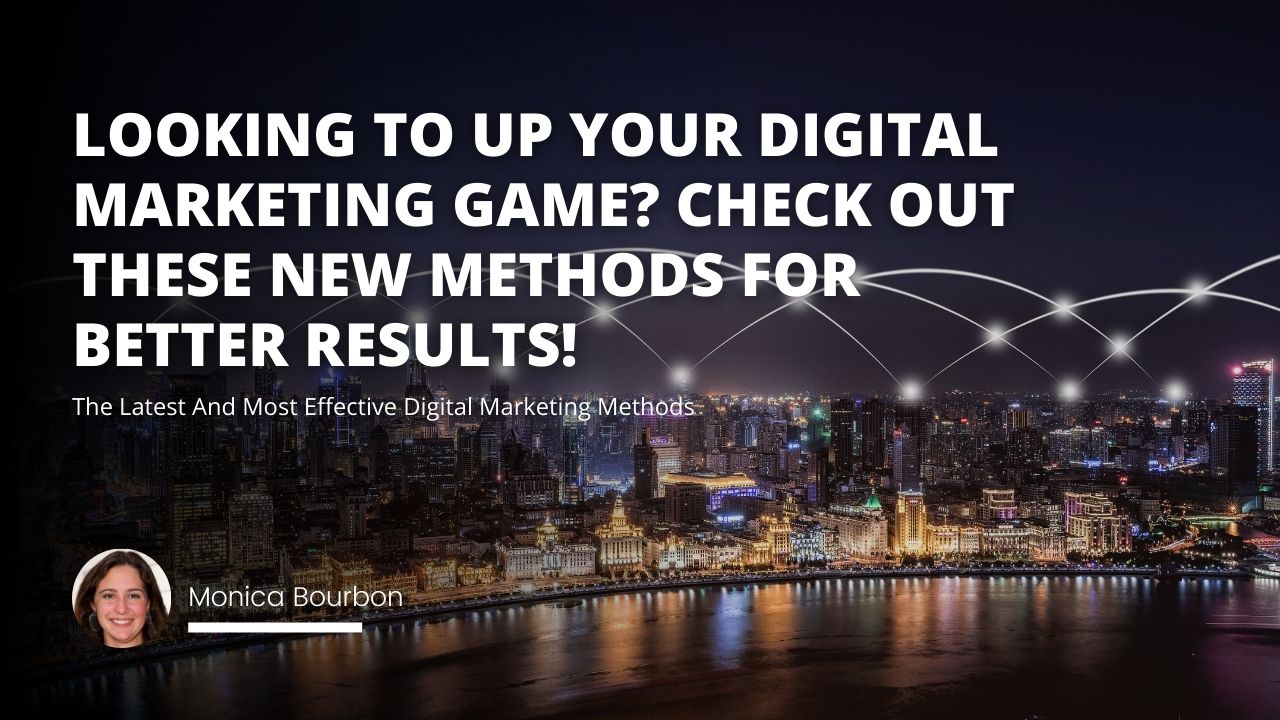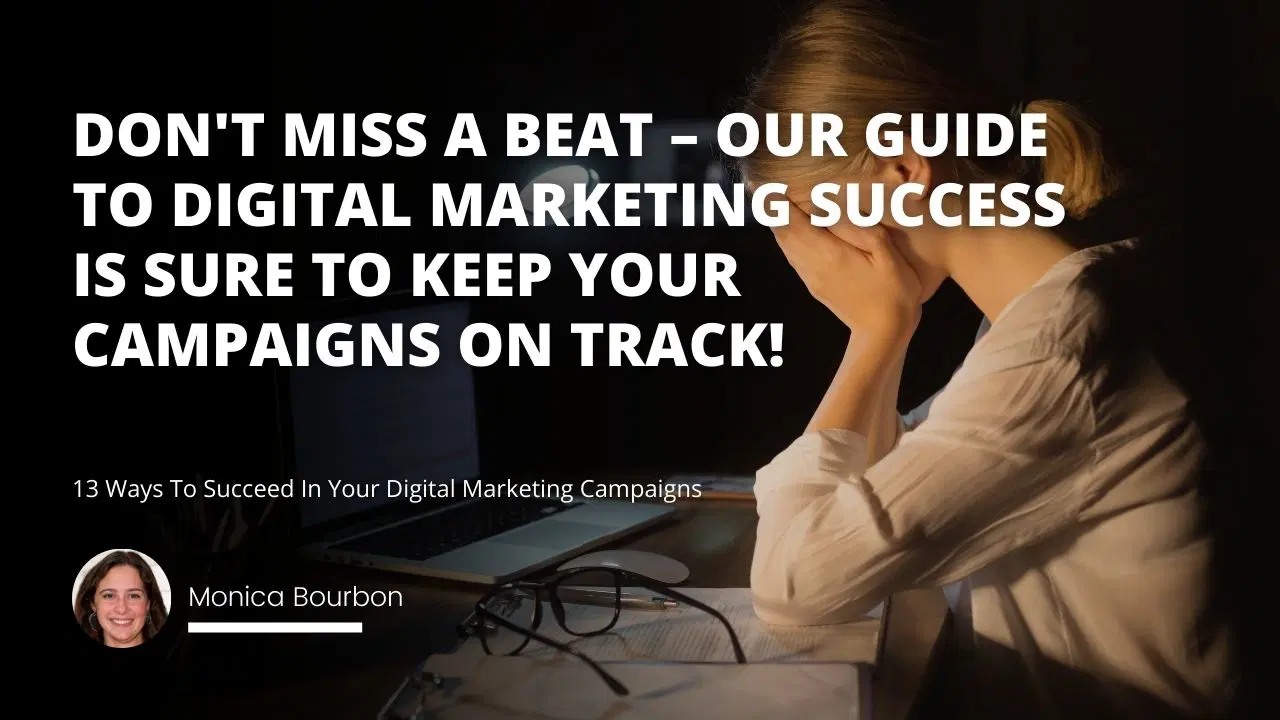
Digital marketing is a complex and constantly-evolving field. Figuring out the proper techniques can feel daunting, but you can achieve success with a bit of planning and creativity. Here are 13 tips that will help you get the most out of your digital marketing campaigns.
The best ways to boost your digital marketing campaign results
As the world becomes increasingly digitized, so too do marketing campaigns. To reach the broadest possible audience, it is essential to have a solid Digital Marketing Strategy. However, simply having a website and social media accounts is not enough. To really boost your results, you can do a few key things:
Make sure your website is optimized for search engines. This means using relevant keywords and providing fresh, informative content regularly.
Use social media to its fullest potential by periodically posting engaging content and interacting with your followers.
Don't forget to take advantage of email marketing; personalized messages are more likely to be opened and read than generic ones.
You can ensure that your digital marketing campaign gets the results it deserves by following these tips.
Define your objectives.
The best way to boost your digital marketing campaign results is to first define your objectives. The most important thing to understand is what you want your campaign to achieve. Once you know your dreams, you can develop strategies and tactics focused on achieving those objectives. For example, if your goal is to increase brand awareness, you might focus on creating high-quality content that can be widely distributed. If your goal is to generate leads, you might focus on developing a solid call-to-action that encourages prospects to take action. By defining your objectives upfront, you can ensure that your digital marketing campaign is designed for success.
Know your audience.
The best way to boost your digital marketing campaign results is to know your audience. First, it is essential to understand who you are trying to reach with your message. This includes understanding their needs, wants, and pain points. Once you know your audience, you can develop marketing materials designed to appeal to them. For example, if you are trying to reach working mothers, you might create content that speaks to their challenges and the solutions you offer. By understanding your audience, you can create marketing campaigns that are more likely to resonate with them.
Choose the proper channels.
The best way to boost your digital marketing campaign results is also by choosing the proper channels. There are various channels that you can use to reach your target audience. These include things like email, social media, and paid advertising. The key is to choose the most likely channels to reach your target audience. For example, if you are trying to get working mothers, you might want to focus on channels like social media and email marketing. You can ensure that your message reaches the right people by choosing the proper channels.
Create compelling content.
Creating compelling content is the best way to boost your digital marketing campaign results. This means making interesting, informative, and relevant content for your target audience. It should also be visually appealing and easy to read. It is essential to understand what your audience wants and needs to create compelling content. For example, if you are trying to reach working mothers, you might want to create content that helps them balance work and home life. You can ensure that your target audience will keep coming back for more by creating compelling content.
Optimize your website for search engines.
The best way to boost your digital marketing campaign results is also by optimizing your website for search engines. This means using relevant keywords and providing fresh, informative content regularly. To optimize your website for search engines, it is essential to understand how they work. For example, Google uses algorithms to determine which websites should be ranked higher in their search results. By understanding how search engines work, you can make sure that your website is designed in a way that will help it rank higher.
Use social media effectively.
The best way to boost your digital marketing campaign results is also by using social media effectively. This means creating engaging content and using the right hashtags. It also means building relationships with influencers in your industry. To use social media effectively, it is essential to understand how it works. For example, each social media platform has its algorithms that determine what content is shown to users. By understanding how social media works, you can ensure that your content is seen by the people who are most likely to be interested in it.
Make the most of email marketing.
The best way to boost your digital marketing campaign results is also by making the most of email marketing. This means creating a compelling subject line and providing valuable content in each email. It also means segmenting your list so that you can send targeted emails to each group. To make the most of email marketing, it is essential to understand how it works. For example, each email service provider has its own rules and regulations. By understanding how email marketing works, you can ensure that your messages are delivered to the people who are most likely to be interested in them.
Drive traffic to your website.
The best way to boost your digital marketing campaign results is also by driving traffic to your website. This means using effective SEO techniques and promoting your website on social media. It also means running ads on search engines and using pay-per-click advertising. To drive traffic to your website, it is essential to understand how it works. For example, each search engine has algorithms that determine what websites are shown in their results. By understanding how search engines work, you can make sure that your website is designed in a way that will help it rank higher.
Generate leads and sales.
The best way to boost your digital marketing campaign results is also by generating leads and sales. This means creating compelling offers and making it easy for people to purchase your products or services. It also means building relationships with potential customers and staying top of mind. It is essential to understand how it works to generate leads and sales. For example, each lead generation method has its own strengths and weaknesses. By understanding how lead generation works, you can make sure that your campaigns are designed in a way that will help you achieve your objectives.
Measure your results.
The best way to boost your digital marketing campaign results is also by measuring your results. This means setting goals and tracking your progress. It also means understanding what metrics to track and how to interpret them. To measure your results, it is essential to know how it works. For example, each metric has its own importance and uses. By understanding how metrics work, you can ensure that you are tracking the right ones for your business.
Keep up with the latest trends.
The best way to boost your digital marketing campaign results is also by keeping up with the latest trends. This means staying up-to-date with the latest changes in the digital marketing landscape. It also means experimenting with new ideas and strategies. To keep up with the latest trends, it is essential to understand how they work. For example, each movement has its own advantages and disadvantages. By understanding how trends work, you can ensure that you are using them to your advantage.
Be creative and think outside the box.
The best way to boost your digital marketing campaign results is also by being creative and thinking outside the box. This means coming up with new ideas and looking at things from different perspectives. It also means taking risks and trying new things. To be creative and think outside the box, it is essential to understand how it works. For example, each situation is different and requires a different approach. By understanding how creativity works, you can ensure that you are using it to your advantage.
Persevere and never give up!
The best way to boost your digital marketing campaign results is also by persevering and never giving up. This means continuing to work hard even when things are tough. It also means being resilient and bouncing back from setbacks. To persevere and never give up, it is essential to understand how it works. For example, each person has their own unique set of challenges. By understanding how perseverance works, you can ensure that you are using it to your advantage.
By following these 13 tips, you will be well on your way to success in your digital marketing campaigns!
So there you have it – a comprehensive guide to digital marketing. Although it can seem daunting at first, once you understand the basics and put in some effort, you can achieve excellent results. If you're looking for more guidance or want to learn how to apply these principles in a real-world setting, we offer an online digital marketing course that will take your skills to the next level. With our help, you can successfully navigate the ever-changing world of digital marketing and achieve outstanding results for your business. So are you ready to get started?
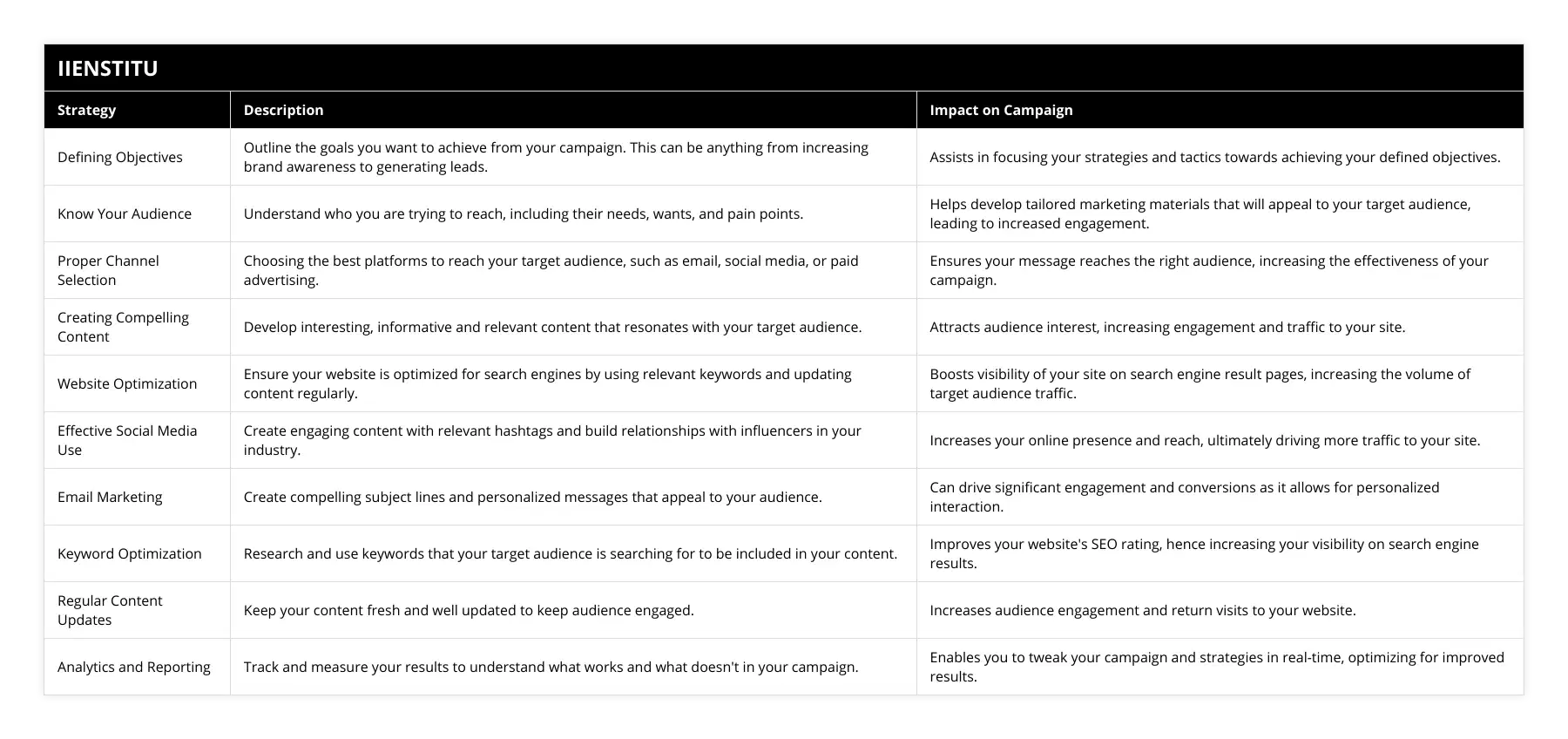
Frequently Asked Questions
How do you succeed in a digital marketing campaign?
Understanding the Target Audience
To succeed in a digital marketing campaign, one must first understand the target audience. This can be achieved through market research and the collection of relevant data, such as demographics, preferences, and online behavior. By gathering this information, marketers can create a buyer persona, which provides valuable insights into the audience's desires and pain points.
Setting Clear Goals
Establishing clear goals for the campaign is essential. These goals should be specific, measurable, achievable, relevant, and time-bound (SMART). Specific objectives enable the digital marketer to develop a focused strategy and measure the success of the campaign. In addition, identifying key performance indicators (KPIs) helps in tracking progress and making necessary adjustments.
Creating Engaging Content
High-quality content is the cornerstone of an effective digital marketing campaign. Marketers should create compelling, unique, and engaging content that adds value to the audience’s experience. This content must be consistent with the brand's message and tailored to the target audience’s interests. Providing valuable information in varied formats—such as blog posts, infographics, webinars, and videos—can increase visibility and encourage interaction.
Utilizing the Right Platform
Selecting the appropriate digital marketing channels is vital for a campaign's success. Several platforms, like social media, email marketing, search engine optimization (SEO), and pay-per-click advertising (PPC), can be employed. Each channel has its advantages, and their effectiveness depends on the target audience’s preferences and the brand's unique needs. Therefore, marketers should invest their resources in the right mix of channels for maximum reach and impact.
Analyzing and Optimizing Performance
Continuous analysis and optimization of the campaign's performance are critical elements in achieving success. Regular monitoring of the campaign's KPIs and other relevant metrics, such as traffic, conversions, and engagement rates, enables marketers to identify areas for improvement. Through this evaluation, necessary adjustments to the strategy can be made, optimizing the campaign for better results.
In conclusion, a successful digital marketing campaign hinges on understanding the target audience, setting clear goals, delivering engaging content, selecting appropriate marketing channels, and continuously analyzing and optimizing performance. By adopting a comprehensive, data-driven approach, digital marketers can enhance their campaigns' effectiveness and achieve their objectives.
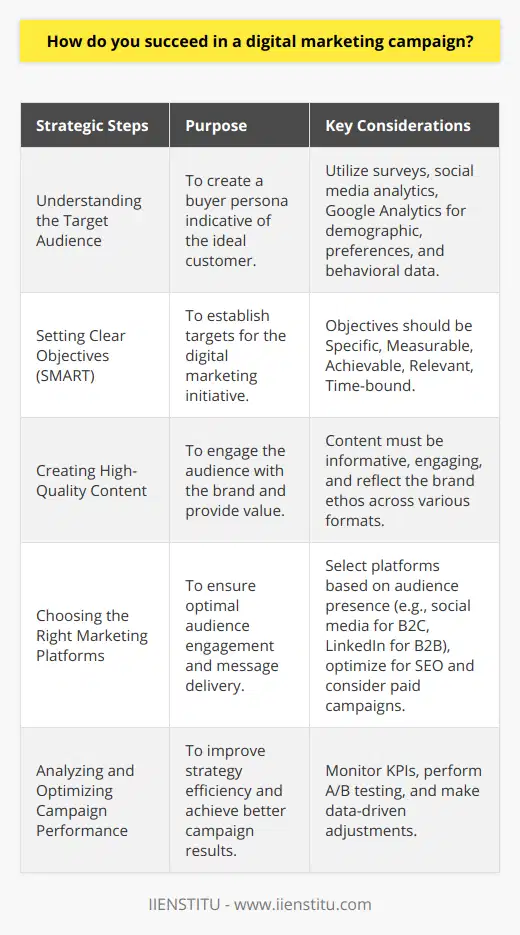
What are the 10 steps to creating a digital marketing strategy?
Understanding the Process
A digital marketing strategy is essential for modern businesses to thrive in an increasingly competitive online environment. To create an effective digital marketing strategy, follow these ten steps:
Analyze the Market
Start by analyzing your target market through demographic research and identifying customer preferences, behaviors, and habits. This will help tailor your marketing activities to specific customer segments.
Set Clear Objectives
Define your marketing objectives, ensuring they are Specific, Measurable, Achievable, Relevant, and Time-bound (SMART). These objectives will provide direction for your digital marketing activities.
Allocate Resources
Allocate appropriate resources, including budget and personnel, to accomplish marketing objectives. This may involve hiring marketing professionals or outsourcing tasks to digital marketing agencies.
Establish Key Performance Indicators (KPIs)
Determine KPIs to measure the success of your digital marketing activities. KPIs should align with your objectives and allow you to track progress efficiently.
Conduct Competitor Analysis
Evaluate your competitors' digital marketing efforts to identify gaps in their strategies and gain insights into your target audience's preferences within your niche.
Develop Your Content Strategy
Create a content plan that engages your target audience and promotes brand awareness. This may include blog posts, articles, videos, infographics, and other forms of multimedia content.
Optimize Channels
Optimize your website, social media profiles, and email marketing efforts for search engine visibility and user experience. These optimizations will improve your reach and performance.
Utilize Paid Advertising
Leverage paid advertising strategies, such as pay-per-click (PPC) or social media ads, to increase your online visibility and drive targeted traffic to your website.
Implement SEO Techniques
Utilize search engine optimization (SEO) techniques to improve your website's search engine rankings, ensuring greater online visibility and driving organic traffic to your site.
Monitor and Evaluate
Continuously track your digital marketing activities, measuring success through KPIs, and making adjustments as needed. Regular evaluations will ensure your digital marketing strategy remains effective and targeted towards achieving your objectives.
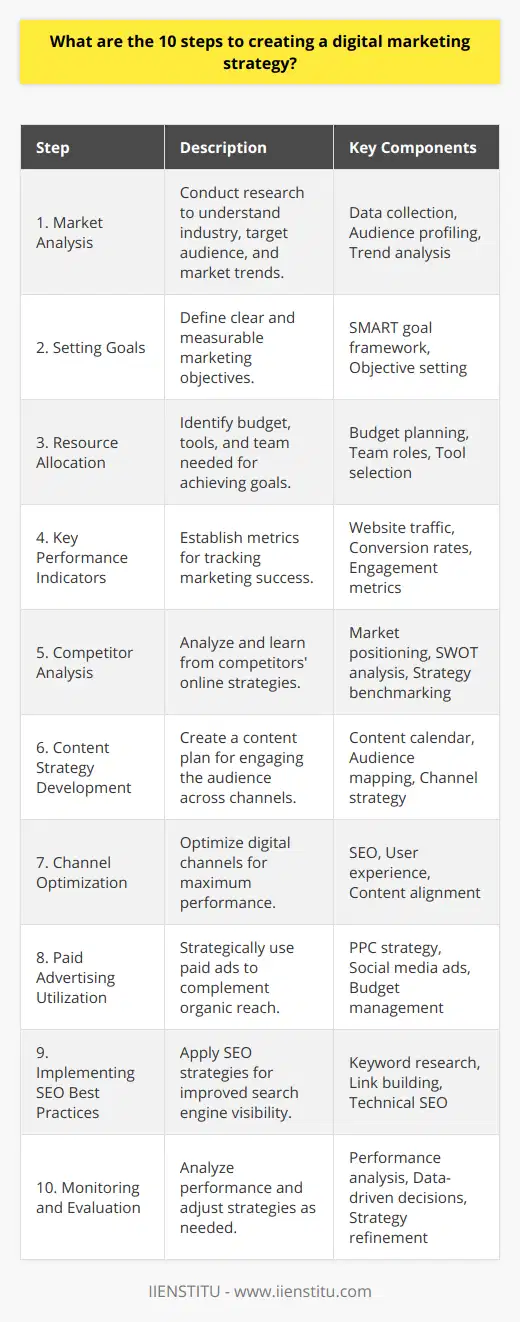
What is the meaning of 4 Ps?
The Concept of the 4 Ps
The 4 Ps, also known as the marketing mix, are a widely recognized and essential tool for marketing management. The concept refers to the four key elements of marketing, including Product, Price, Place, and Promotion. These elements, when combined strategically, allow marketers to effectively communicate their offerings to target customers, create value proposition, and achieve competitive advantage in the marketplace.
Product: Essence and Features
The product aspect of the 4 Ps encompasses the goods or services that a company offers to its customers. Marketers need to consider factors such as design, features, quality, and packaging to create compelling offerings that cater to the needs and expectations of the target audience. A thorough understanding of customer preferences allows organizations to develop products that are well-positioned for market success.
Price: Determining Value
Pricing is a delicate balancing act, as it involves the customer's perceived value of the product and the company's desired profit margin. Marketers must take into account factors such as competition, production and distribution costs, and target market income levels to set appropriate prices. A well-devised pricing strategy can help establish an image of quality, attract the right market segment, and foster long-term brand loyalty.
Place: Strategies for Distribution
The place element pertains to the distribution and accessibility of a company's products. A successful distribution strategy ensures that products are easily available to customers when and where they are needed, thus optimizing convenience and reach. Businesses can choose from various distribution channels, such as direct sales, wholesalers, retailers, and e-commerce platforms, to ensure the right combination of coverage and cost-efficiency.
Promotion: Effective Communication Techniques
Promotion entails the communication methods employed by businesses to inform, persuade, and remind customers about their products. This aspect of the marketing mix includes advertising, public relations, personal selling, and sales promotions. Marketers must carefully design promotional campaigns that align with the company's objectives, resonate with target customers, and differentiate the brand from competitors.
In conclusion, the 4 Ps represent a fundamental marketing framework that assists businesses in designing and executing successful marketing strategies. By focusing on product, price, place, and promotion, companies can effectively address customer needs, create value, and differentiate themselves in a competitive environment. Thus, the 4 Ps continue to serve as a cornerstone for effective marketing management.
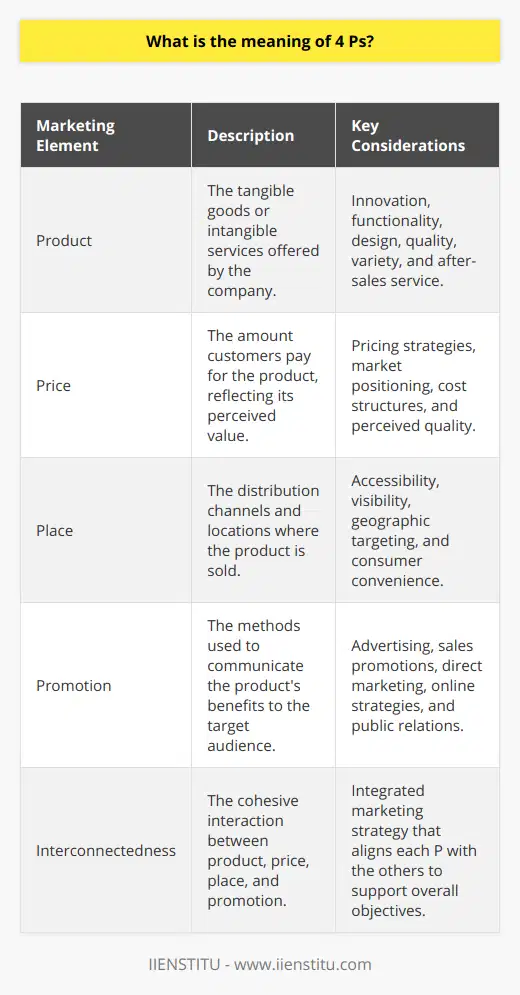
What are the 5 main strategies of digital marketing?
**Introduction to Digital Marketing Strategies**
Digital marketing is constantly evolving, with marketers seeking to engage audiences through various online channels. To better understand the core components of an effective digital marketing campaign, the following discussion presents the five main strategies that professionals often utilize.
**1. Search Engine Optimization (SEO)**
The first strategy, Search Engine Optimization (SEO), involves optimizing website content, structure, and performance to improve its ranking on search engine results pages. This process enhances the visibility of a brand or product, consequently driving organic, non-paid traffic to the site.
**2. Content Marketing**
Another critical component is content marketing, which focuses on creating high-quality, informative, and engaging content that appeals to a target audience. This approach aims to attract, retain, and ultimately convert readers into customers, fostering long-term loyalty and trust in a brand.
**3. Social Media Marketing (SMM)**
Social media marketing (SMM) refers to the practice of utilizing social networking platforms such as Facebook, Twitter, and LinkedIn to promote a product or service. The aim of this strategy is to increase brand awareness, generate leads, and facilitate customer engagement.
**4. Pay-Per-Click Advertising (PPC)**
Pay-per-click (PPC) advertising is a strategy in which marketers pay a fee each time an internet user clicks on their ads. This approach can be used on search engines and social media platforms alike, and it enables organizations to precisely target users based on their search query or demographic profile.
**5. Email Marketing**
The final major digital marketing strategy is email marketing, which entails sending relevant, customized messages to a carefully selected list of contacts. This approach allows for direct communication with potential customers, providing an opportunity to nurture leads, solicit valuable feedback, and maintain an ongoing relationship with existing clients.
In conclusion, effective digital marketing strategies incorporate a combination of SEO, content marketing, social media marketing, pay-per-click advertising, and email marketing. By applying these five core approaches, businesses can engage with their target audience, increase brand awareness, and ultimately drive sales and revenue.
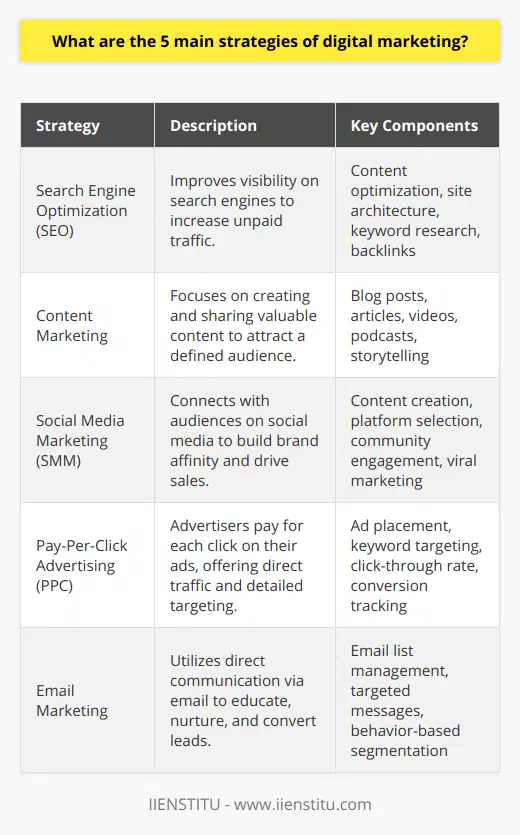
What are the 4 keys of digital marketing?
Four Essential Elements of Digital Marketing
Search Engine Optimization (SEO)
One of the fundamental components of digital marketing is Search Engine Optimization (SEO). SEO aims to enhance a website's visibility on search engine results pages, primarily through organic means. By implementing keyword research, on-page optimization, and link-building strategies, digital marketers can ensure that their content ranks higher and attracts more traffic.
Content Marketing
Content marketing entails creating relevant, informative, and engaging content to attract, inform, and retain an audience while encouraging them to take a desired action. This type of marketing requires expertise in understanding target audience needs and pain points, as well as a knowledge of different content formats, such as text, images, videos, and podcasts. High-quality content has the potential to generate leads, increase brand awareness, and foster customer loyalty.
Social Media Marketing
Social media marketing leverages the power of social networking platforms to connect with target audiences, build brand awareness, and facilitate customer engagement. By creating and sharing content tailored to specific social media channels, digital marketers can foster conversations and interactions with their audience. Furthermore, social media marketing can lead to increased website traffic, improved customer insights, and higher conversion rates.
Pay-Per-Click Advertising (PPC)
Pay-Per-Click (PPC) advertising is an essential element of digital marketing that involves paying for targeted ads displayed on search engine results pages or other platforms. Advertisers can bid on specific keywords relevant to their products or services, ensuring that their ads are only displayed to potential customers actively searching for those offerings. PPC campaigns require careful budget management, keyword research, and ongoing optimization to maximize return on investment.
In conclusion, the four keys of digital marketing – SEO, content marketing, social media marketing, and PPC advertising – serve as crucial components in creating an effective digital marketing strategy. By leveraging these methods and continuously refining their approach, digital marketers can drive brand awareness, generate leads, and ultimately boost business success in the online landscape.
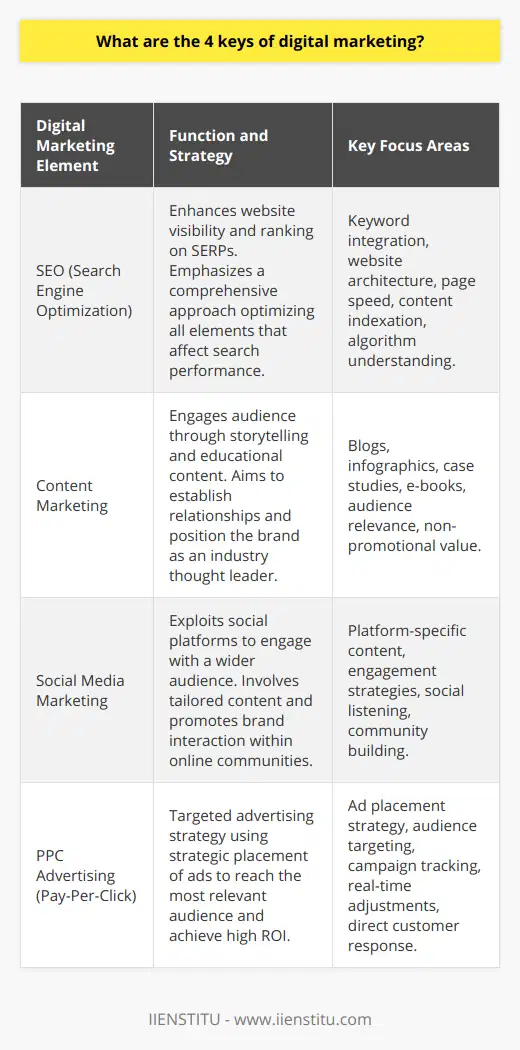
How can one measure the effectiveness of various digital marketing channels?
Digital Marketing Channel Measurement
When assessing the effectiveness of digital marketing channels, it is important to examine multiple performance metrics. These can be divided into three categories: attention, engagement, and conversion. By analyzing these metrics, marketers can understand the overall performance of their marketing efforts and optimize their strategies.
Attention Metrics
Initially, attention metrics can help gauge the reach and awareness created by a marketing channel. These include impressions, reach, frequency, and cost per thousand impressions (CPM). By examining these indicators, one can determine the effectiveness of a marketing channel in capturing the audience's attention and expanding the brand’s visibility.
Engagement Metrics
Next, engagement metrics can demonstrate a target audience's interaction with the content. Some common indicators are clicks, likes or reactions, comments, shares, and click-through rate (CTR). These metrics inform us about how the target audience interacts with specific marketing channels and help evaluate their resonance within the audience.
Conversion Metrics
Finally, conversion metrics reveal the impact of marketing channels on the bottom line. Examples include conversion rate, cost per conversion, return on investment (ROI), and average transaction value. These metrics are crucial for understanding whether our marketing efforts are driving sales or other important outcomes.
Analysis and Optimization
By comprehensively evaluating attention, engagement, and conversion metrics, marketers can have a clear understanding of the effectiveness of different digital marketing channels. Moreover, it empowers them to optimize marketing strategies by focusing on high-performing channels that drive engagement and conversion. Performing this analysis regularly enables organizations to stay competitive in the digital marketing landscape and meet their desired objectives.
In conclusion, measuring the effectiveness of digital marketing channels requires a deep understanding of various performance metrics. By regularly analyzing and optimizing these metrics, organizations can make informed decisions regarding channel selection to maximize their marketing efforts and achieve desired outcomes.

What is your top 3 digital marketing strategies to attract clients?
Effective Digital Marketing Strategies
Customer Engagement through Content Creation
One of the top digital marketing strategies to attract clients is through engaging content creation. High-quality, informative, and relevant content is essential for establishing a strong online presence, building credibility, and demonstrating expertise in the industry. Content marketing can take various forms, such as blog posts, videos, podcasts, and infographics, to cater to different preferences and consumption habits of the target audience. The primary focus should be on providing value to potential clients, addressing their pain points, and offering solutions to their problems.
Search Engine Optimization (SEO) for Visibility
Another crucial digital marketing strategy is search engine optimization (SEO), which aims to improve a website's ranking on search engine results pages (SERPs). Higher visibility on SERPs translates to increased organic traffic, providing more opportunities to convert visitors into clients. An effective SEO strategy involves identifying and incorporating relevant keywords, creating quality content, improving website speed, and acquiring authoritative backlinks. Additionally, focusing on local SEO by optimizing Google My Business listings and incorporating local keywords can be particularly beneficial for attracting clients in the targeted geographic area.
Utilize Social Media for Targeted Campaigns
The third digital marketing strategy for attracting clients is leveraging social media platforms. Social media marketing offers the advantage of targeting specific demographics, interests, and behaviors, allowing businesses to reach their ideal clients more effectively. Utilizing popular platforms such as Facebook, Instagram, LinkedIn, and Twitter, businesses can share engaging content, run targeted ad campaigns, and foster relationships with their audience. Furthermore, social media platforms enable businesses to showcase their personality and humanize their brand, facilitating trust and loyalty among potential clients.
In conclusion, creating engaging content, optimizing SEO, and leveraging social media platforms are three digital marketing strategies to effectively attract new clients. By implementing these tactics, businesses can maximize their online visibility and foster relationships with potential clients, driving growth and long-term success.
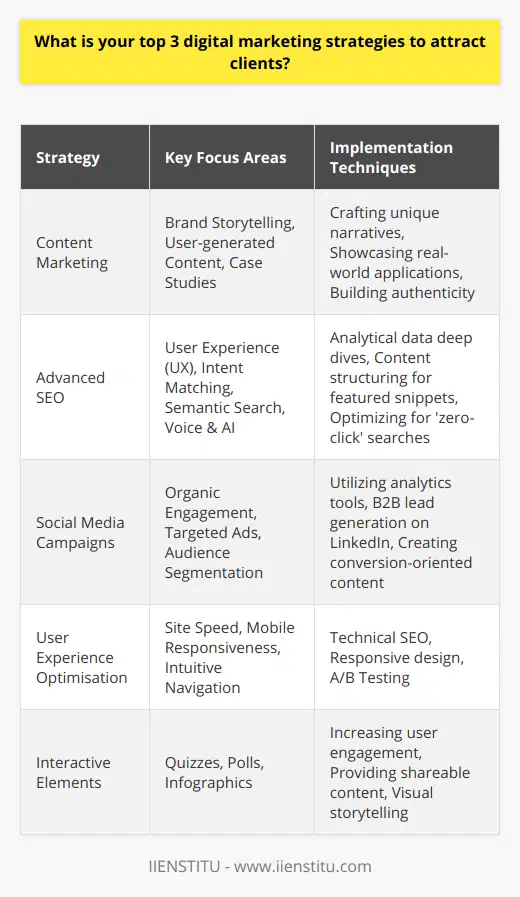
What are the essential components of an effective digital marketing campaign?
Essential Components of Effective Digital Marketing Campaigns
Target Audience Identification
The first important component in an effective digital marketing campaign is the identification of the target audience. It is crucial to understand the demographics and preferences of the potential customers to create a tailored and engaging digital marketing campaign.
Clear and Relevant Message
An effective digital marketing campaign must have a clear and relevant message, which appeals to the needs and desires of the target audience. This helps to convey the benefits and values of the product or service offered, ultimately leading to increased customer engagement and conversions.
Multi-Channel Approach
Utilizing a multi-channel approach allows for greater reach of the digital marketing campaign. By employing various platforms such as social media, email marketing, content marketing, and online advertising, businesses can target a wider audience and increase the likelihood of achieving the desired results.
Marketing Automation Tools
The use of marketing automation tools is an essential component of an effective digital marketing campaign. These tools help to streamline marketing tasks, track customer interactions, and manage data, consequently improving overall marketing efficiency and maximizing the return on investment.
Analytics and Performance Measurement
Measuring the performance and results of a digital marketing campaign is necessary to determine its effectiveness. By analyzing data through performance metrics and key performance indicators (KPIs), businesses can identify opportunities for improvements and adjustments to the digital marketing strategy.
Continuous Improvement
Finally, a successful digital marketing campaign requires continuous improvement and adaptation. It is vital to keep up with the latest trends and best practices in digital marketing, make data-driven decisions, and regularly refine the digital marketing strategy to ensure ongoing success.
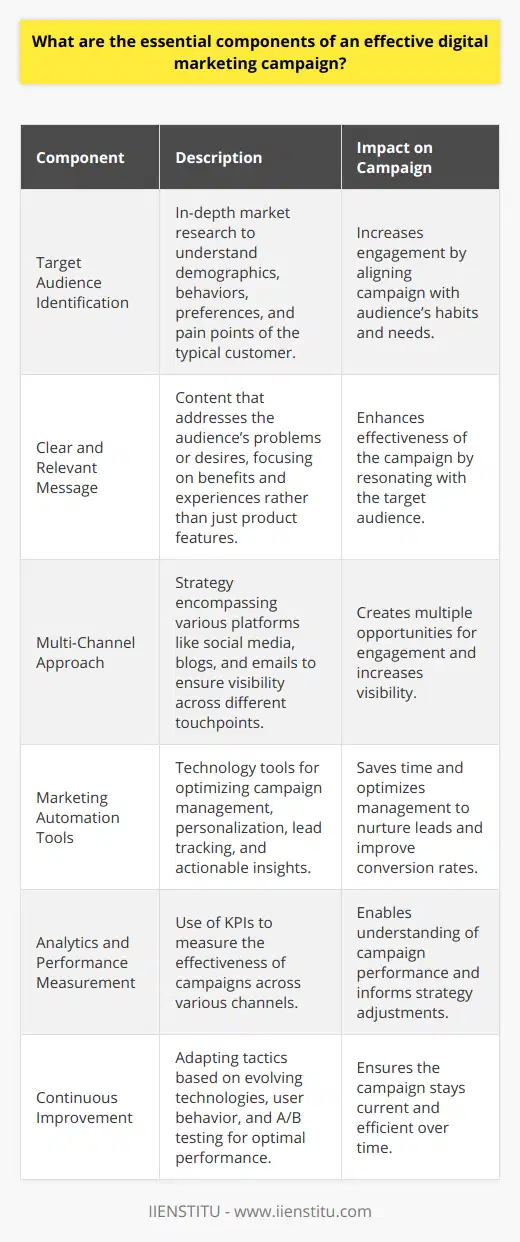
How can businesses leverage emerging technologies to enhance their digital marketing efforts?
Utilizing Advanced Technologies
Businesses can leverage emerging technologies to enhance digital marketing efforts by utilizing advanced tools that improve reach, targeting, and engagement. One way to achieve this is through incorporating artificial intelligence and machine learning algorithms. These algorithms analyze consumer behavior patterns, allowing marketers to design highly personalized campaigns that resonate with the target audience.
Integrating Chatbots
Integrating chatbots is another technique businesses can employ, offering quick and efficient customer service. This not only improves customer satisfaction but also allows businesses to collect valuable data on customer preferences and queries. This data can be used to refine marketing strategies and tailor content to better align with user expectations.
Implementing Augmented and Virtual Reality
Additionally, businesses should consider implementing augmented and virtual reality technologies to provide immersive and interactive experiences. These technologies enable customers to engage with products and services in innovative ways, fostering a deeper connection with the brand. Moreover, the novelty of such experiences is likely to generate buzz, thereby boosting brand visibility.
Adopting Influencer Marketing
Another emerging trend in digital marketing is the adoption of influencer marketing. By partnering with influencers who have a strong online presence, businesses can access new audiences, enhance credibility, and strengthen brand awareness. This is especially effective for companies targeting younger demographics, who are increasingly relying on social media and online interactions to inform their purchasing decisions.
Leveraging Big Data and Predictive Analytics
Lastly, leveraging big data and predictive analytics can provide businesses with valuable insights into customer needs, preferences, and future trends. By harnessing this information, companies can focus efforts on creating highly targeted and relevant marketing campaigns. Predictive analytics can also aid in identifying sales triggers, allowing marketers to adapt their strategies in real-time.
In conclusion, businesses can enhance their digital marketing efforts by embracing a variety of emerging technologies, such as artificial intelligence, chatbots, augmented and virtual reality, influencer marketing, and predictive analytics. These tools not only improve targeting and personalization but also create unique and memorable user experiences, giving businesses a competitive advantage in the digital landscape.
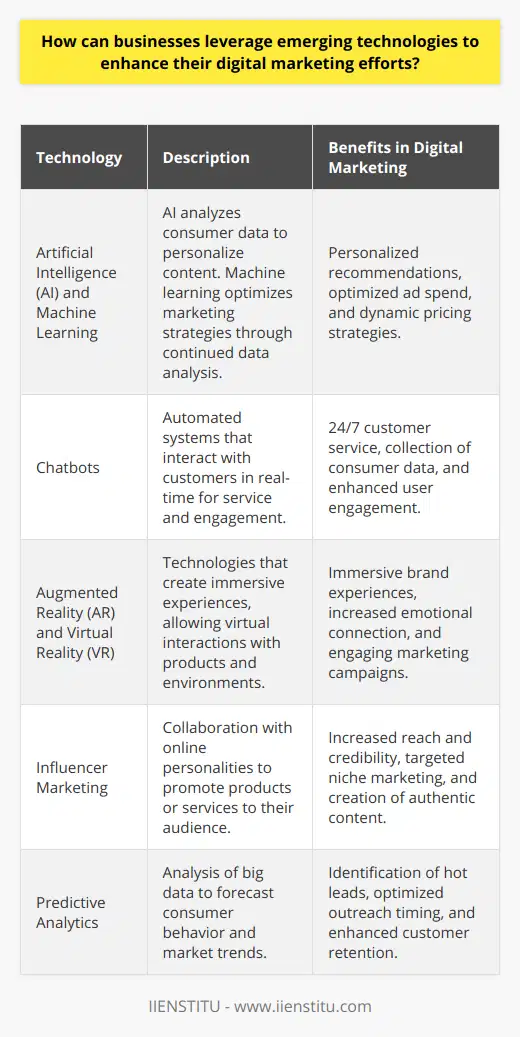
What are the 3 keys to a successful campaign?
Unique Value Proposition
The first key to a successful campaign is crafting a unique value proposition. A campaign’s success mainly hinges on its ability to differentiate itself from others. The uniqueness aids in attracting target audiences, persuading them to support the campaign because it offers something extraordinary that other campaigns lack. This requires comprehensive market research, competitor analysis, and an understanding of customer behaviors and preferences.
Effective Communication
Secondly, effective communication plays a crucial role in a successful campaign. This entails clear conveyance of messages about the campaign’s objectives, missions, and benefits. Communication should emphasize the campaign value and benefit to supporters. Effective communication also means reaching the target audience through the right channels, whether via social media, email, traditional advertising, or public relations.
Robust Evaluation Metrics
Lastly, the success of a campaign largely depends on the use of robust evaluation metrics. These are necessary for gauging campaign success, identifying what worked and what didn't, and providing insights for future improvements. Campaign managers should identify specific, measurable, achievable, relevant, and time-bound (SMART) objectives to guide the campaign and measure effectiveness. Crucial measurement tools or metrics may include the number of new supporters or customer conversions, engagement rates on media platforms, and the number of times campaign materials were shared or liked.
In summary, for a campaign to be successful, it needs to have a unique value proposition, effective communication, and robust evaluation metrics. These three elements serve as the cornerstone for any campaign aiming to stand out, resonate with their audience, and achieve their objectives.

How can data-driven insights be effectively incorporated into digital marketing strategies?
Incorporating Data-Driven Insights into Digital Marketing
Data-driven insights play a pivotal role in formulating proactive digital marketing strategies. By utilizing big data, marketers can make evidence-based decisions, thereby enhancing their marketing efficiency.
Understanding Customer Behavior
Understanding consumer behavior is the cornerstone of any marketing strategy. Marketers can use data analytics tools to study customer preferences and behaviors, thereby identifying key market trends. These insights help firms design customer-centric strategies, tailor offerings, and optimize user engagement.
Personalized Marketing Efforts
Data analytics also facilitates personalized marketing, a modern strategy that greatly enhances customer satisfaction. Harnessing data insights enables marketers to send individualized messages and offers, thereby bolstering customer relationships and loyalty.
Optimized Marketing Channels
A data-driven approach also aids in channel optimization. By analyzing customer engagement across different channels, marketers can identify the most effective platforms, optimize ad placement, and allocate resources strategically.
A/B Testing for Enhanced Performance
Marketers can use A/B testing to compare the performance of two versions of a webpage, ad, or email. Data analytics provides precise results, enabling the improvement of marketing elements that yield better conversion rates.
Predictive Analysis for Future Trends
Lastly, predictive analytics leverages data to forecast customer behavior, market trends, and business opportunities. Accurate predictions lead to timely interventions and proactive strategies which, in turn, enhance business growth and profitability.
In conclusion, incorporation of data-driven insights into digital marketing strategies can significantly optimize marketing efforts, yield better conversion rates, and ultimately contribute to increased profitability and customer satisfaction. This is a paradigm shift from conventional marketing and a step towards a more scientific, data-based approach to digital marketing.
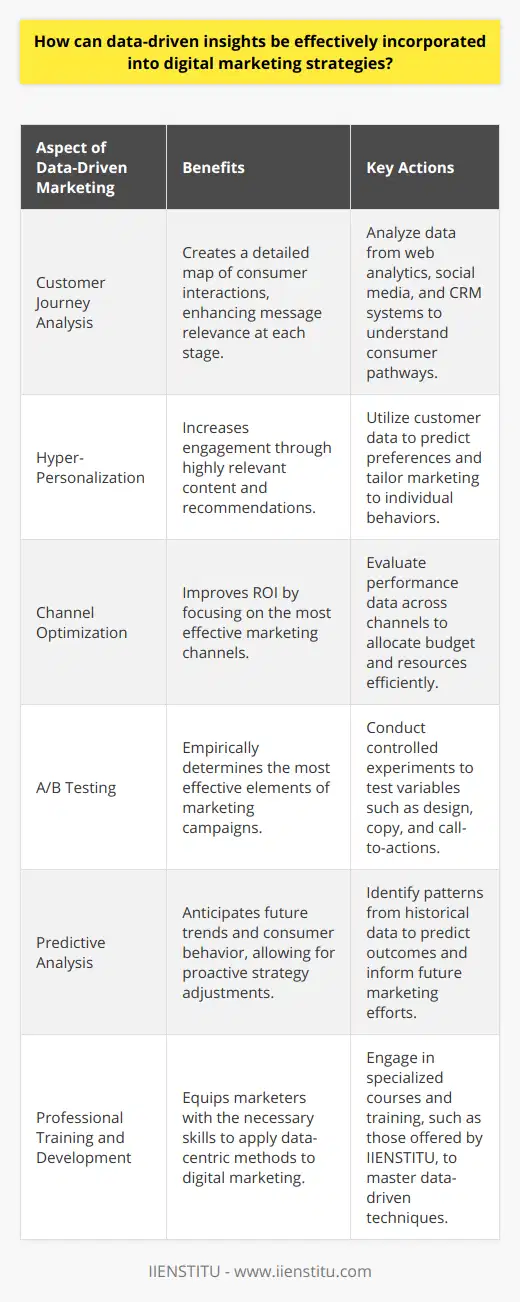
What are the most critical metrics and KPIs that businesses should track and analyze to optimize their digital marketing efforts?
Key Performance Indicators (KPIs) for Digital Marketing
Businesses must define and track key performance indicators (KPIs) to optimize their digital marketing strategies.
Website Traffic Metrics
Website traffic stands among the most crucial KPIs. It measures the number of people visiting a website. Businesses should also observe the sources of site traffic, whether direct, from search engines, or referrals. Tracking these will help define the effectiveness of marketing efforts.
Lead Generation, Conversion Rates
Understanding the conversion rate helps companies assess the effectiveness of their marketing tactics. Further, businesses should analyze the number of new leads and opportunities generated from digital marketing activities. These KPIs are significant in determining if marketing efforts are yielding desired results.
Engagement Metrics
Interactive elements such as likes, shares, and comments on social media posts are critical engagement metrics. They denote the interest and active involvement of the audience. Tracking these can help improve social media strategies.
Customer Retention Rates
Customer retention rate measures the number of customers who remain loyal over a period. High retention implies successful customer engagement and satisfaction which leads to repeat business.
Email Marketing Metrics
Email marketing metrics, including click-through rates and open rates, depict how well the target audience receives emails. Analyzing these can aid in enhancing email marketing strategies.
Cost Metrics
Analyzing cost-per-click (CPC) and cost per acquisition (CPA) informs businesses about the financial efficiency of their digital marketing strategies. Lower costs usually indicate more effective strategies.
Analyzing these critical metrics and KPIs allows businesses to fine-tune their digital marketing efforts for optimal results. In conclusion, businesses can enhance their marketing strategies with a continuous measure and analysis of these KPIs.

What are the five things you need to create a successful digital marketing plan?
Understanding the Target Audience
In creating a successful digital marketing plan, the basic requirement is understanding the target audience. This involves knowing their preferences, their buying behavior, and their demands, so as to attract them.
Creating Clear and Measurable Goals
A well-defined goal provides a clear direction in creating a digital marketing plan. It should be specific, measurable, achievable, relevant and time-bound (SMART) so organizations can track their success and make necessary adjustments.
Building a Strong Online Presence
Being visible online is crucial for every business. Choose the suitable platforms considering your target audience. Pay attention not just to the number of online followers, but more importantly, their level of engagement.
Implementing SEO Strategies
Search Engine Optimization (SEO) is a crucial component in digital marketing. It improves the visibility and ranking of your website on search engines. It can attract organic traffic, providing potential customers with relevant content that matches their search queries.
Monitoring and Analyzing Results
Tracking and analyzing the digital marketing plan's performance are vital. It allows the business to recognize areas of improvement and to revise strategies. It helps optimize the overall digital marketing plan, ensuring it stays effective and adaptable to changing trends.
Overall, these five key elements, when combined and executed effectively, can create a successful digital marketing plan that can drive the company towards achieving its desired outcomes.
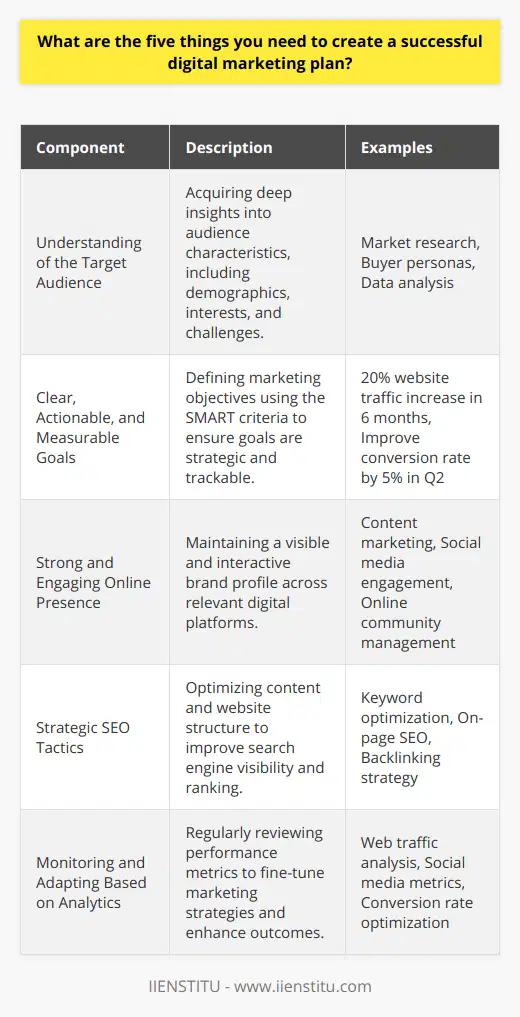
How do the principles of traditional marketing compare and contrast with digital marketing approaches?
Traditional Marketing vs. Digital Marketing
Traditional marketing principles and digital marketing strategies show fundamental similarities and differences. Both strategies aim to increase brand awareness and generate sales. However, the methods and platforms used to achieve these goals significantly differ.
In traditional marketing, we rely on the physical presence and tangible marketing channels. Billboard advertisements, brochures, direct mail, and TV commercials are common forms. Word-of-mouth marketing still holds importance in this model. These methods target a broad audience and add a personal touch, which can build strong emotional bonds.
On the other hand, digital marketing uses Internet-based platforms. Social media advertising, email marketing, search engine optimization, and content marketing are prevalent forms of digital marketing. These methods offer detailed audience targeting, real-time data, and performance metrics. They facilitate effective adaptability and optimization.
Digital marketing encourages two-way communication. It allows businesses to engage with their audience efficiently and receive immediate feedback. In contrast, traditional marketing proposes a one-way communication model, limiting instant feedback.
However, traditional marketing has a wider reach, especially in areas with poor Internet coverage. Digital marketing struggles to permeate such areas.
Now, we consider the cost factor. Traditional marketing involves a high cost compared to digital marketing. Results measurement is easier in digital marketing. Traditional marketing methods may not offer specific analytics and accurate conversion data.
In essence, traditional marketing and digital marketing exhibit core differences and similarities. Effectiveness depends on the target audience, company goals, and budget. Thus, marketers should strive for a balanced, hybrid approach, incorporating the right mix of both strategies to maximize reach and return on investment.
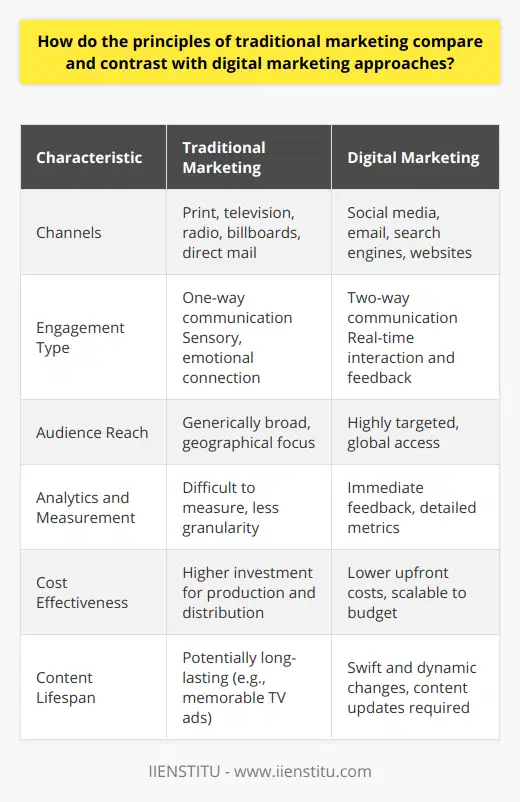
Can you suggest any best practices for integrating online and offline marketing initiatives?
Developing a Consistent Brand Message
A best practice in integrating online and offline marketing is maintaining a uniform brand message. Your brand speaks to your clientele; thus, it has to remain consistent across all marketing channels. Whether you're online or offline, your voice, tone, design, and messaging should uphold a unified presentation.
Leveraging Social Media with Physical Locations
Make good use of social media to boost your offline marketing initiatives. For example, announce in-store events on social media platforms. Likewise, encourage in-store customers to follow your online platforms for exclusive deals and promotions. This strategy creates a synergy between your online and offline presence.
Maximizing SEO and Local Marketing
Another practice involves integrating search engine optimization (SEO) tactics with local marketing. Online, conduct keyword research to optimize your content. Offline, encourage foot traffic by harnessing the power of local SEO, like Google My Business listings. These two strategies will complement and magnify the impact of each other, helping to drive more traffic both online and offline.
Capitalize on Data Insights for Decision Making
Appreciate the value of data generated from both online and offline channels. Using data analytics tools, monitor, record, and analyze customer behavior. Utilizing the resulting insights can inform decision making, help refine marketing strategies, and ensure better alignment with your target audience’s needs.
Combining Online Offers with Offline Purchases
Lastly, a practical tactic is integrating online promotions with offline purchases. Offering deals available solely in physical stores can incentivize digital audiences to visit your physical locations. On the other hand, providing online coupons to in-store customers can promote further shopping experiences on your online platforms.
To summarize, integrating online and offline marketing requires consistency, convergence, effective use of SEO, data utilization, and strategic use of promotions. The aforementioned practices, when effectively combined, will undoubtedly maximize your marketing outcomes.



